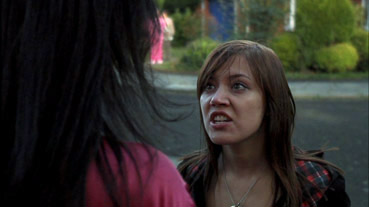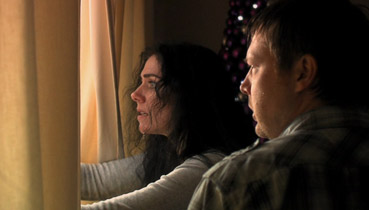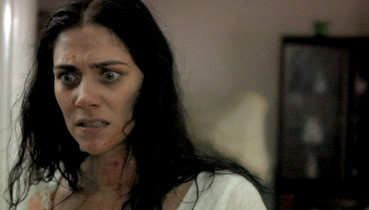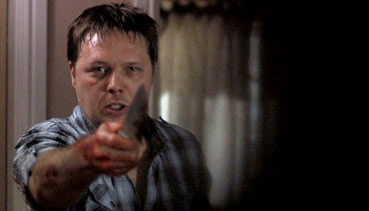|
Maybe it's me, but when I hear the phrase 'new low budget British horror movie' I tend to get just a little twitchy, perhaps because almost every time I sit down to watch one I end up hoping that the filmmakers' next project will be more to my liking. So to encounter one that grabbed me from its opening scene and gets so many things right gave me a considerable thrill. But to talk about why in any detail presents me with a dilemma, as it's also one of those films that you'll get more from if you know only the vaguest details of the plot. So the best and simplest advice I can give is to only read to the end of the third paragraph of this review, skim through the summary, then rent or buy the movie, ignore the blurb on the box and just watch it. Some of you won't like it and I can't help that, that's an inevitable consequence of individual taste. But if you do connect with it then you'll really benefit from that lack of foreknowledge. If you want to know more regardless then stay with me and I'll endeavour to keep the spoilers to a bare minimum.

The film kicks off in what seems like traditional horror movie fashion, with an unspecified threat introduced before the main characters so that we can get nervous when they later arrive at this very location. Here it results from a paperboy eavesdropping on a row between Asian house owner Mr. Sharma and his wife and being angrily chased into the woods, where he is bloodily killed by an unseen assailant. But there's something off-kilter about the angles and edits that give the whole sequence a sense of curious unease. And there's more being set up here than the presense of a lethal menace.
It's then that we meet teenage Jodie, who is being driven by father Clive to spend Christmas at her estranged mother Beth's house, something she's not remotely happy about. We learn quite a bit about this family and their feelings for each other during the course of the journey, which two fine performances from Linzey Cocker and Dean Andrews sell as utterly real. Clive drops Jodie off on her mother's doorstep, and it's here that the link with the opening scene is established by through a quick glimpse of the aforementioned Mr. Sharma. Dad departs, and after an apprehensive smoke (a quiet, almost Andrea Arnold-esque moment that really registers), Jodie enters the house and catches Beth in bed with one-night-stand Kieran. A fiery bust-up follows that sends Jodie storming off to a nearby friend's house and leave us in the company of her rattled mother and the bemused lover. Ten minutes in and the film has swapped what you've been led to believe were the lead characters for two new ones, one of whom has been given a seriously unsympathetic build-up. It's a bold move that keeps the drama interesting and the audience on its toes.
What it doesn't do is prepare you for the sudden tonal switch that follows a few minutes later when, having failed to convince neighbour Pam and her hostile daughter Leanne to let her see Jodie, Beth is brought suddenly to the ground by an black-clad military figure waving an automatic weapon and shouting at her to stay down. Seconds later, a panicky Mr. Sharma re-appears waving a cleaver and is shot dead on the spot. Beth is loudly ordered to return to her house and to lock all doors and windows and told not venture outside under any circumstances. Well you've certainly got my attention.

What follows plays a little like scaled down take on The Mist, in which a group of unrelated people found themselves trapped in a supermarket by an unidentified and deadly outside menace. But by focusing on just two characters and keeping the nature of the threat ambiguous for a good part of the film, screenwriter Colin O'Donnell and first-time director Lawrence Gough ground the situation firmly in urban reality, feeding very effectively off a range of modern paranoias from home invasion to terrorism in order to explore not a specific threat, but the controlling nature of fear itself. This is terror of the unknown at an elemental level, and it's not out in the forest or up in the old dark house, but lurking on your doorstep, in the back yard, or up in the attic, and you can't reason with it or effectively defend yourself against it because you don't know what it is.
It's thus no surprise that the film works best while this status quo is maintained, with Beth torn between her terror of the unspecified danger outside and her maternal desperation to reach her daughter, who is similarly imprisoned just a few houses away but whose status remains teasingly unknown. The claustrophobic tension is maintained by intermittently upping the stakes – the inexplicable devastation in the house next door, the bloodied neighbour who pleads to be let in (and just what is the deal with that tag on her wrist?), the overheard words of a soldier feeding back to his commander. The problem is that the eventual revelation of what's going on can't hope to live up to such an effective build-up, a low-budget victim to the idea that what you see is never going to be as frightening as what you're able to imagine. But even here the film loses none of its smarts and builds thrillingly to an ending that may initially play like a horror staple, but which makes perfect sense in the context of the maternal subtext.
O'Donnell's script, Gough's precision direction, Stephen Hilton's score, and Simon Tindall's quietly urgent hand-held camerawork (no overdone waggle-cam here) keep the action tight and the mood threatening. But what really sells it is a consistently excellent central performance from Neve McIntosh, who as Beth is required to run the gamut of extreme emotion from wide-eyed terror and tearful desperation to fire-spitting anger, and does so without hitting a single wrong note, her final act scream of primal rage a moment of extraordinary emotional power and release. As the hapless Kieran, Shaun Dooley may have the less prominent role, but in his own quiet way he's every bit as convincing, particularly when exploring his regrets regarding his own family.

The result is almost an object lesson in how to make a low budget first feature around a relatively simple premise. Other first-timers would do well to note the attention paid here to the script, the characters and the actors, three crucial elements that so often leave small scale British horror movies open to attack and even derision. Salvage works because of the thought that has gone into the storytelling, the conviction of the performances and the substance of the subtext, and because it's been made not by referential fan boys, but by people who actually understand what makes horror movies work. It's not without its flaws – panicky people repeatedly creep up on others in complete silence, for one thing – but it's still a seriously impressive start to what I'd hope will prove successful feature career for its makers, and heartening evidence that the British horror movie might just be heading out of the doldrums.
Shot on HD using 35mm prime lenses, often using available light, the image certainly has a low budget look, with a decent contrast, sharpness and colour in brighter scenes tempered by some loss of detail in the shadows, digital grain and a narrower colour range when the light levels drop. But it works for the tone of the film and even adds to the almost subconsciously documentary look created by the hand-held camerawork. A trickier issue is the aspect ratio, which here is 1.78:1 anamorphic but has been listed on a couple of sources as 2.35:1, which on the commentary track director Gordon appears to confirm, but in a way that suggests that a conscious decision was made to frame the film differently for home video. Whether the version here has been cropped at the sides or opened up vertically is unsure, but there's never a sense that we're losing picture information or that the framing either too loose or too tight.
Dolby 2.0 stereo and 5.1 surround tracks are provided; the stereo is louder but the 5.1 has more finesse and makes great use of the surrounds when Beth runs into the woods. There are a couple of times when the mix cries out for a bit more punch to really push the panic button, but for the most part it does the job well.
Commentary with director Lawrence Gough, actor Shaun Dooley, writer Colin O'Donnel & associate producer Alan Pattison
A soft spoken commentary that proves a very informative listen, despite a few "I love this..." comments and a fair amount of describing what we can plainly see with our own eyes. I'd certainly failed to twig that the bulk of the film was shot on the abandoned Brookside Close,* and it's always useful to hear about the technical aspects, restrictions and sometimes ingenious work-around solutions on any low budget film. The development of the script and project is well covered, and plenty of praise is handed out to those involved, with good reason by the sound of it.

Behind the Scenes (10:08)
An unstructured and ramshackle collection of grabbed behind-the-scenes footage and gooning around that reveals surprisingly little about the production. On the commentary track, director Gough suggests that those hired to do the shoot this were using a better camera than he was, but the image quality here tells a different story, and the fidgety camerawork and accompanying comments makes it play more like a home movie than a commissioned work. Maybe there's another making-of documentary that's not been included here. A glitch in the filming or the transfer has added a rather distracting judder to any camera or subject movement.
Interviews with Cast and Crew (44:36)
Actors Neve McIntosh, Shaun Dooley and Linzey Crocker answer the same set of questions about working with each other, their favourite scenes, their views on horror movies and such like. Director Lawrence Gough talks about how the film came about, the themes, the actors and shooting his first feature. Producer Julie Lau outlines how she became involved in the project, her reaction to the script, the challenges of shooting a micro-budget feature, and shooting in Brookside Close. Executive producer Lisa Marie Russo discusses the process of selecting and making the film as part of the Digital Departures project. Production designers Colin Taylor and Malcolm Smith describe how they got involved with the film and the experience of working on it. Just about everyone is asked to describe the film and who they think it will appeal to. A bit of a promo, but still some useful stuff here.
A tightly written and directed tension piece built around an essentially simple idea, bolstered by sturdy subtextual elements and convincing performances across the board. You can keep the making-of documentary, such as it is, but the commentary and interviews are worthwhile inclusions, and for the film alone this has to come recommended.
* For non-UK readers, Brookside was a long-running British soap opera set around the families on a Liverpool cul-de-sac, which was custom built for the series and has largely sat empty since the show was cancelled in 2003.
|